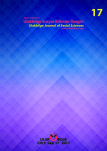ŞANLIURFA CÜLHACILIĞI ve GÜNÜMÜZDEKİ DURUMU
SANLIURFA CULHACILIĞI AND PRESENT DAY USES OF THIS
Author(s): Semra Kiliç KarataySubject(s): Cultural history, Customs / Folklore, Sociology of Culture
Published by: Sanat ve Dil Araştırmaları Enstitüsü
Keywords: Sanliurfa; Culha; Culhacilik; cloth; weaving;
Summary/Abstract: Şanlıurfa is the first settlement place of humanity history and it hosted three divine religions to come into being, it produced a lot of civilizations and values, by keeping these values for itself shared with all humanity.Şanlıurfa is an ancient city in which agriculture was done for the first time , the first university was founded, it was called as fertile crescent in the past, it has a value and richness which can be enough for every individual for centuries.Handicrafts are profit making products depending on individuals' knowledge and skill, in which especially natural raw materials are used, being made with hands or with basic tools, carrying society's culture- customs and traditions, and reflecting emotion thoughts and skills of the individuals who produce. Handicrafts which are the most beautiful examples of our material culture has an exclusive place in world handicrafts because defines Turkish folk culture and it carries this culture with its variety and art value from the past to the future. Şanlıurfa has also a rich quality in respect of handicrafts as it carries these cultures' characteristics.Handicrafts like aba making, felt making, coppersmith, carpet rug weaving, çulhacılık, çulculuk, silk embroidery, furriery, woodcraft are made.Çulhacılık, cloth weaving,is an art that forms scarfs like yamah(neçek-çefiye) and puşu,women robe like pyramid(ehram), vala, fıta ; by weaving wool, cotton and floss string in çakarlık which is a kind of whip loom with one foot and in pull-push looms with 2- 4 foot.At the researches, it will be informed that the history of çulhacılık, weaver loom, products weaved in weaver looms and their varieties, classifying of the products, weaving stages and the last status of weaved products.
Journal: Ulakbilge Sosyal Bilimler Dergisi
- Issue Year: 5/2017
- Issue No: 17
- Page Range: 1781-1794
- Page Count: 14
- Language: Turkish

